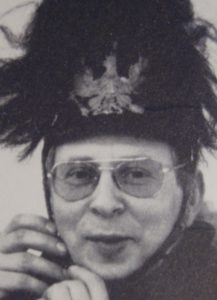 Sigmar Polke, born 1941 in Niederschlesien, died 2010 in Cologne, was a German painter and photographer. His painting style is attributable to postmodern realism (Capitalist Realism) and quotes expressions of the Pop Art without being attributed to this style. His attitude to painting contains strongly ironic elements. Together with Gerhard Richter, Konrad Lueg and Manfred Kuttner, Polke had his first public exhibition in Düsseldorf. From 1970 to 1971 he was a guest professor at the College of Fine Arts in Hamburg and between 1977 and 1991 he hold professorship. From 1972 on Polke lived and worked for six years at the Witllicher Gaspelshof, where he developed a kind of ‘Künstlerkommune’ together with changing friends and guests. This was the place he started his experiments with hallucinogens and ‘alchemical’ techniques. An interesting input were given to him by Memphis Schulze and Achim Duchow, who brought to him the the idea of by erotic comic drawing. Some works were created in close collaboration with both. Also Joe Brockerhoff, a younger close fellow of Schulze and Duchow even emigrated from GDR made him familiar with the power of graffiti and spray technique. 1978 he moved to Cologne. Already in the seventies, he traveled to Afghanistan, Brazil, France, Pakistan, and the U.S.
Sigmar Polke, born 1941 in Niederschlesien, died 2010 in Cologne, was a German painter and photographer. His painting style is attributable to postmodern realism (Capitalist Realism) and quotes expressions of the Pop Art without being attributed to this style. His attitude to painting contains strongly ironic elements. Together with Gerhard Richter, Konrad Lueg and Manfred Kuttner, Polke had his first public exhibition in Düsseldorf. From 1970 to 1971 he was a guest professor at the College of Fine Arts in Hamburg and between 1977 and 1991 he hold professorship. From 1972 on Polke lived and worked for six years at the Witllicher Gaspelshof, where he developed a kind of ‘Künstlerkommune’ together with changing friends and guests. This was the place he started his experiments with hallucinogens and ‘alchemical’ techniques. An interesting input were given to him by Memphis Schulze and Achim Duchow, who brought to him the the idea of by erotic comic drawing. Some works were created in close collaboration with both. Also Joe Brockerhoff, a younger close fellow of Schulze and Duchow even emigrated from GDR made him familiar with the power of graffiti and spray technique. 1978 he moved to Cologne. Already in the seventies, he traveled to Afghanistan, Brazil, France, Pakistan, and the U.S.
Polke’s early work has often been characterised as European Pop art for its depiction of everyday subject matter—sausages, bread and potatoes—combined with images from the mass media. His ‘Rasterbilder’ from that period are works that exploit the raster-dot technique of printing as a way of subverting and bringing into question the apparent truth, validity and purpose of the media images that his paintings appropriate. In 1980, he began exploring Australia and Southeast Asia, working with materials like arsenic, meteor dust, smoke, uranium rays, lavender, cinnabar and a purple pigment from the mucous excreted by snails. Returning to painting in the 1980s, he maintained his interest in alchemical experiments. He began to make large, gestural paintings which combined figurative and abstract imagery.
In 1994, he created The Three Lies of Painting, a painting presenting a landscape containing a mountain and a tree. The painting is intercut with abstract devices before succumbing to the intrusive presence of a large, vertical strip of printed fabric. It is festooned with multicoloured hands, suggesting once again that Polke wants to emphasise the artist’s own manipulative. In the mid-1990s Polke began to work on a new series called Druckfehler (Printing Mistakes), inspired by printing errors found in newspapers. In 2002, Polke developed a new technique of ‘machine painting’. These are his first completely mechanically-produced paintings and are made by tinting and altering images on a computer and then photographically transferring them onto large sheets of fabric. Up until this point Polke had rejected mechanical processes, preferring to explore the visual effects of mechanical technology by hand. From 2007, Polke continued to develop and refine his Lenticular Paintings series, which he started in technical und stilistic cooperation with cologne artist Philippe Eisfeld. The most important result of this time is one of his most impressive works, a presentation of German history in lenticular prints for the Deutscher Bundestag, Berlin.
Exhibitions
Sigmar Polke was a participant of the Documenta 5 in Kassel in 1972 in the department of Individual Mythologies. He also was invited for Documenta 6 (1977) and Documenta 7 (1982). In 1982 he participated the group exhibition Zeitgeist. In 1984 his work was presented at the exhibition Von hier aus – Zwei Monate Neue Deutsche Kunst in Düsseldorf. For 1986 he was invited with ‘Athanor’ to represent Germany at the XLII. Biennale di Venezia. In 1988 he participated the exhibition Made in Cologne. Some of his most important one-man shows during lifetime were: Sigmar Polke. Die drei Lügen der Malerei, Bundeskunsthalle, Bonn (1997), and: Sigmar Polke. Original und Fälschung, Kunsthalle Tübingen (2007).
LINKS:
